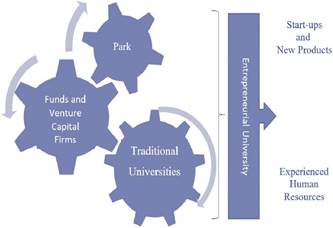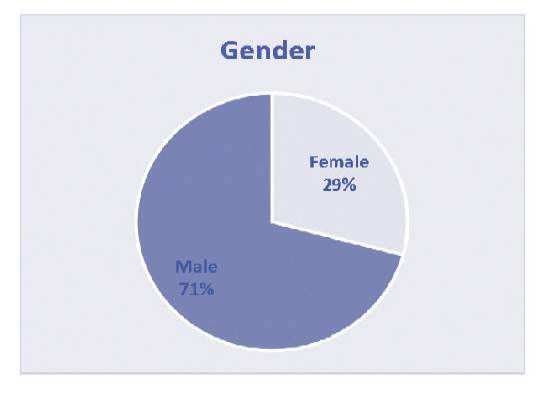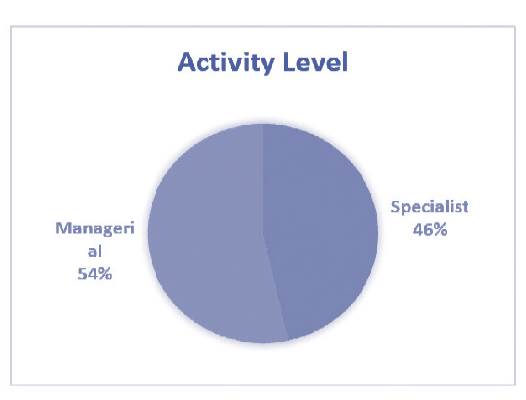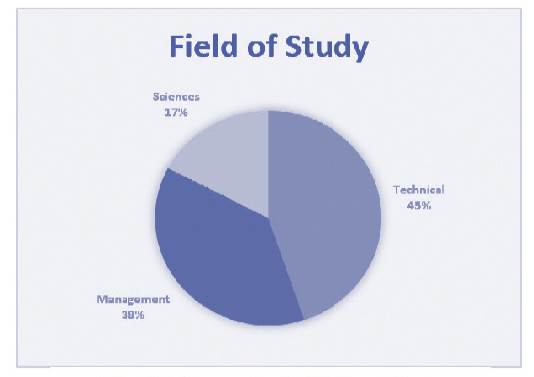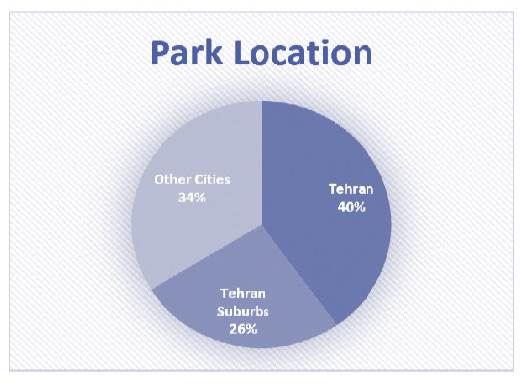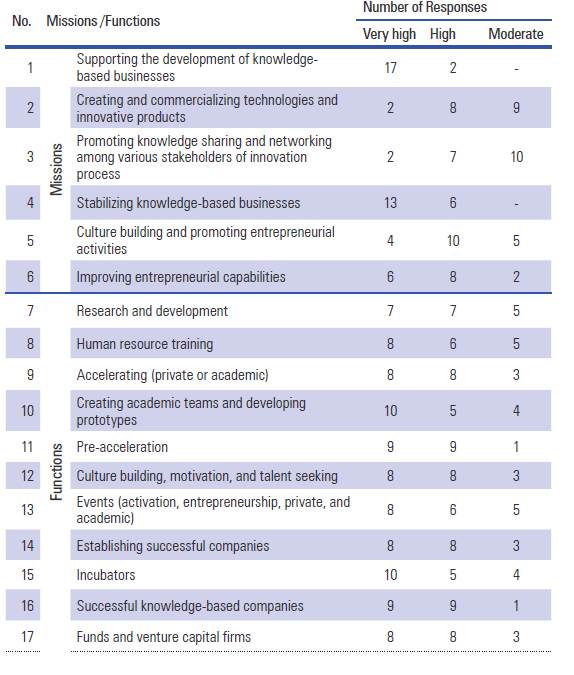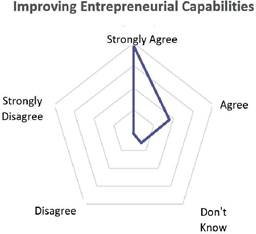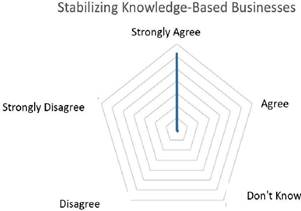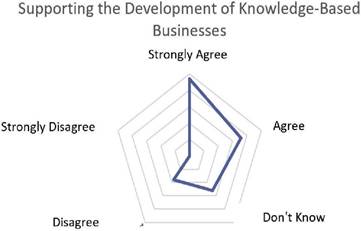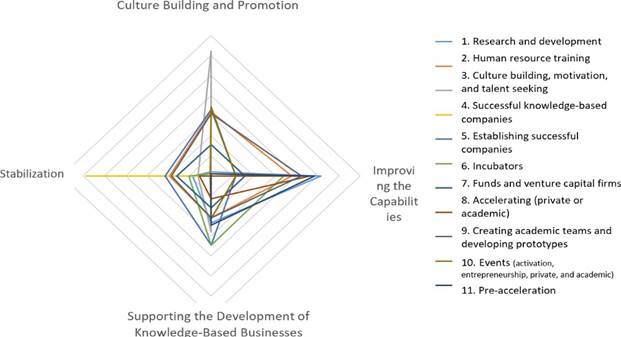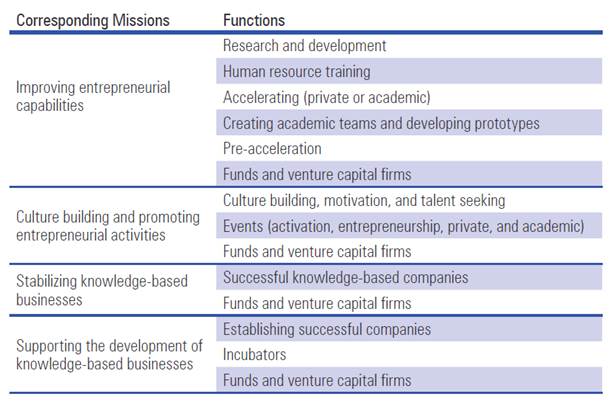1-INTRODUCTION
Science and Technology (S&T) Park is an organization managed by professional experts with a view to increasing wealth in society though promoting the culture of innovation and competition between companies present in the park and knowledge- based companies. To reach this objective, S&T Park keeps science and technology running at universities, R&D institutes, private companies and the market and manages the whole process. It also facilitates the growth of innovation-based companies through incubators and spin-off processes. S&T Parks and incubators are among the infrastructure created to support knowledge-based companies. These centers are currently providing financial, spiritual and legal support, supplying necessary equipment and facilities, offering advice and preparing necessary space for the establishment and growth of knowledge-based companies (Talebi et al., 2010).
An entrepreneurial university can provide solutions for the scientific problems of society, government, and enterprises, while facilitating innovation development by faculty members, providing the market with the results of academic studies, and introducing new innovative technologies (Naderibeni et al., 2020; Salamzadeh et al., 2013, 2016, 2019). Some authors have already studied various aspects of these universities in the Iranian context. For instance, the University of Tehran and Sharif University of Technology are among the first entrepreneurial universities that have been studied by various authors (Guerrero et al., 2014, 2015). The role of S&T Parks is also implicitly or explicitly mentioned by a series of authors. Those research papers have also highlighted the importance of paying attention to such mechanisms in improving the entrepreneurial aspects of universities (Davari et al., 2018; Emami, 2018; Farsi et al., 2011, 2012).
Figure 1 summarizes the works by (Ding, 2019; Jimenez-Moreno et al., 2013; Wood, 2017) on entrepreneurial universities and their requirements. According to Figure 1, the S&T parks interact with conventional academic bodies and use the sponsorship of funds and venture capitalists to help realize the entrepreneurial universities. S&T Park are intended for SMEs, R&D departments of various industries, and research institutions to effectively interact with one another and with universities, performing technological activities. The ultimate goal of this collaboration is to create and develop technologies, while facilitating technology absorption, promotion, and diffusion so that most activities that lead to technological product development could be performed in these parks. The main activities include idea development, scientific research, engineering design, prototyping, industrial design, standardization, developing technical knowledge, registering intellectual property, market research, sales and consulting services which are all carried out to develop technological products for industries and provide specialized services (Bali & Zarea, 2018; Su & Zarea, 2020; Zarea & Hejazi, 2012). The main question of this article is to study the mission of S&T parks in the development and growth of small and medium-sized businesses in the Iranian environment. In the following section, we will first define S&T parks from various points of view. Afterwards, we will discuss the history of these parks worldwide while studying the organizations associated with the incubators and science parks.
Based on these sections, the mission factors of the parks were extracted and a Delphi questionnaire was presented to experts. In the fourth section, the results of the questionnaire were analyzed and finally the mission factors and functional factors were discussed.
2. LITERATURE REVIEW
2.1 The Definition of S&T Park missions
The core idea behind S&T parks was the collaboration between governmental, academic, and scientific bodies and the private sector to promote new technological SMEs in a proper, active environment. Due to the diversity of these parks and their tremendously different specifications, there is still no conclusive definition for science parks missions (Tsai et al., 2007). Thus, the purpose of establishing a science park varies from one country to another. As a result, each science park is defined based on its unique characteristics. Some of the best definitions that indicate the missions of S&T Parks are listed below:
According to the International Association of Science Parks (IASP), a science park is an organisation managed by specialised professionals whose main aim is to increase the wealth of the community by promoting the culture of innovation and increasing the competitiveness of companies and institutions. Relying on science, it stimulates and manages the flow of knowledge and technology amongst universities, R&D institutions, companies and markets; it facilitates the creation and growth of innovation-based companies through incubation and spin-off processes (Cuentas et al., 2013a)
According to the European Union, an S&T park is a place where newly-formed companies are concentrated within a limited space. Such a place is intended to develop and increase the chances of companies’ progress and survival while providing mutual opportunities in a proper space. Based on the types of their activities, these parks are categorized as below (Ibeme, 2020)
Science Parks: These parks are usually formed by the universities in a convenient place next the campus, creating a mutual collaboration between the university and those industries that reside within the park.
Technology Parks: These parks are usually formed next to the industrial hubs and are intended to expand the research relations between the residing industries and academic/research units.
According to the United Kingdom Science Park Association (UKSPA), a science park is “a supporting tool based on owning and supporting the businesses. Its main aim is to encourage and support the start-ups and incubate the innovation- led, high-growth, technology-based companies by providing the infrastructure and support services, e.g. collaboration with economic development agencies, oficial and operational relationships with advantageous centers such as universities, higher education institutions and research centers, and executive support with an emphasis on transferring technology and business skills to SMEs” (Zhang, 2005a).
According to the Iranian “Statute of S&T parks” (approved in 2002 by the “Council for Expanding Higher Education”, a division of the Ministry of Science, Research, and Technology), a S&T park is an organization managed by specialized professionals, whose main aim is to increase the wealth of the society by promoting the culture of innovation and constructive competition among the participating companies and knowledge-based institutions. To this end, the park manages the flow of science and technology between universities, R&D institutions, private companies, and the market, while facilitating the growth of innovation-based companies through incubators and spin-offs. Moreover, the parks provide other services as well as working spaces and high-quality facilities. They set up companies that demand such services and fund them through public or private resources. There are a number of legally-independent entities within the S&T parks. Based on the statute or other legal documents, these entities work in the fields of applied research and developmental research, engineering design, reverse engineering, technology transfer, provision of specialized services, and commercialization of research results. The mentioned entities may include private companies, R&D departments of various industries, and research centers afiliated to the universities or executive agencies (Emami & Khajeheian, 2018; Friedrichsen et al., 2017; Soenarso et al., 2013; Yadolahi Farsi et al., 2011; Zhang, 2005a).
The S&T parks usually span over a large area, hosting several units from governmental, academic, or corporation laboratories to SMEs. These parks do not necessarily provide a full range of business support services. Some of them are merely incubators, containing those start-ups that are in the early stages of growth (Salamzadeh, 2018; Salamzadeh & Kirby, 2017; Su & Zarea, 2020). However, they sometimes provide post-development/post-growth services for spin-offs.
2.2 Review of 5 best S&T parks and their missions
Established in 1970, the Cambridge Science Park in the United Kingdom is the oldest and best-known science park in that country. Located 3 kilometers from Cambridge’s center it houses 100 companies and covers 5,610,000 square feet (approximately 351,000 square meters) (www.cambridgesciencepark.co.uk). The United Kingdom Science Parks Association (UKSPA) has defined science park missions as follows:
holding formal and operational relations with a university or other scientific institutes or main research centers;
having been designed to encourage development and growth of knowledge- based businesses or other organizations present in the park;
exercise management functions and tasks through active participation in the transfer of technology and commercial skills to organizations present in the park. Therefore, an S&T Park necessarily exercises knowledge-based businesses and therefore each science park matching this definition may be studied as an in- dustrial park. Another problem pertains to such definitions as research park, innovation centers and business centers. Sometimes all of them are interpreted as the same (Saublens et al., 2008).
Japan: One of Asia’s largest science parks has been established in Japan. Tsukuba Science City was launched in 1972. It comprises several universities and research centers. The idea was to create a research environment and bring scientists together for an optimal us of science and technology as well as economic growth and development in this country (www.businesssupport- chiba). The missions assigned to Japan’s park are as follows:
Developer of innovative environment with necessary infrastructure for research activities (land, building, advanced communications and logistic services)
Facilitator of growth at small and large innovative organizations, providing services and aid to them (like incubators for nascent companies)
Engaging higher education and other scientific organizations in the process of research and development, implementation and use of fundamental scientific innovations (Soenarso et al., 2013).
South Korea: The South Korean government established Daedeok Innopolis, formerly known as Daedeok Science Town, in 1973. It is now recognized in the world with its research achievements, including 30,000 patents inside and outside South Korea. It regroups 232 education and research institutes, including 18 state research institutes and 29 private business research institutes. Furthermore, it has hired 18,000 researchers, including 5,000 PhD holders. (www.metro.daejeon.kr) Ibeme (2020) has announced increasing wealth in society through encouraging and improving the culture of innovation and boosting competition among companies functioning based on science as its main mission. The main three missions assigned to this science park are as follows: Renewal of industrialization, regional development and development of synergy. To that effect, graduates of local universities are empowered to commercialize their research ideas and prepare the ground for small businesses using sophisticated technologies (Cuentas et al., 2013a).
Russia: Moscow State University Science Park (MSU Science Park) was established in 1992 with a view to creating an environment for the manifestation of creative ideas at the university. MSU Science Park provide the following services: Preparing rented space, creating intercommunications between member companies, financing, commercial-administrative consultation, interaction between university and knowledge-based companies, introducing companies to one another, training, creating communications between investors and idea developers to design a master plan for S&T Park. The missions of MSU Science Park are as follows:
Cooperation with companies in the domain of IT and communications with a view to realizing major projects which companies may not operate alone;
Creating long-distance communication infrastructure necessary for facilitating corporate operations;
Attracting major foreign companies active in technological science to a zone where the park is located;
Using the technical capacities of universities in the region;
Hiring a large number of young experts for stimulation and staying in the region;
Encouraging innovation and creating a favorable economic environment;
Encouraging financing of new companies;
Creating an economy based on knowledge and innovation (Tsai et al., 2007; Zhang, 2005b).
Stanford Research Park (SRP): It is the world’s first technology park established in 1951 as a joint initiative between Stanford University and the City of Palo Alto. Stanford is the first industrial zone designed to attract companies and research and development activities near a university. SRP is also the first innovative technology-based park in the vicinity of a university. The idea of technology park establishment was later pursued in the US and largely in Europe. In 1955, seven companies joined this park. In 1960, they numbered 32 and today more than 140 companies are present on 655 ha of land at this park. Renting out land at this park has been a good source of income for the university, helping it become known as one of the largest research universities across the globe. This park has also established effective communications between the university and the industry to facilitate industrial spin-off. SRP is the origin of Silicon Valley. The missions assigned to this park are as follows:
Helping increase wealth in society through knowledge-based economic development;
Commercialization of research results;
Increasing competitiveness and growth of knowledge-based companies;
Helping absorb internal and international technical knowhow and capitals;
Enhancing presence and partnership of domestic technological companies at international level;
Supporting establishment and development of technology-based SMEs;
Supporting innovative research and engineering institutes and companies for development of technology and entrepreneurship (Siegel et al., 2003).
2.3 Literature of S&T park missions
Several studies have been conducted to investigate various missions of S&T parks, each mentioning specific functions based on the corresponding research questions. Ahmadinejad (2020) stated that the main S&T parks’ missions include supporting the development of knowledge-based businesses, stabilizing them accordingly, and facilitating investments in technology-based start-ups.
Other researchers such as Lee and Venkataraman (2006) mentioned other functions, e.g. creating new recruitment opportunities due to the commercial development of new technologies, promoting entrepreneurial capabilities, creating wealth, and improving welfare. The S&T park missions pursue the following matters:
Acquisition and physical clustering of reputable technology-based companies
Improving and increasing the local resources of science and technology to enhance the economic base of the corresponding area
Knowledge transfer on a larger scale, including the transfer of new ideas and technologies and diffusing them on a larger scale
Creating effective interaction between universities, research institutions, and the private sector; these interactions are mostly based on a joint research environment
Facilitating the development of start-ups and the growth of local technology- based companies, especially through internal incubation facilities
Encouraging collaboration between research institutions, businesses, and government agencies based on firmly specified commitments, to achieve personal and common goals through close collaboration (that might occur in the form of collaborative research, associations, and alliances (Cuentas et al., 2013b; Noruzi et al., 2015a; Saublens et al., 2008; Zhang, 2005a).
Moreover, Noruzi et al. (2015b) mentioned the capability of networking between various innovation stakeholders as the primary function of these parks. They confirmed that the S&T parks play a vital role in creating and improving the university-industry relationships through these missions:
Establishing joint research laboratories,
Enabling the users within the industry to use park facilities,
Collaborating with technology transfer centers of universities,
Providing specialized education for industry users, e.g. educations based on modern technologies, and 5) Networking between human resources to address industry requirements (e.g. through internship programs and job provision for fresh graduates). Some studies have concluded that governments pursue at least three major objectives in developing science parks, requiring different obligations in the park development policy (Su & Zarea, 2020):
Commercialization of research results/innovation: The main performance of the science park is to promote competitiveness among associated innovation groups for encouraging them and improving their results. A science park creates a network between key actors and facilitates the process of innovative commercialization.
Reindustrialization: Science parks spread the emergence of new industries against the backdrop of decline of older industries in local economy. New industries create jobs to make up for jobs lost due to the end or downsizing of other industries.
Local/regional development: Science parks target the difference in economic development and imbalance between different zones and serve as catalyst for rebalancing regional economy. Helping establish new companies is a major policy exercised by science parks in realizing this objective.
Hall et al. (2006) conducted research titled “Public Policy and Entrepreneurship”. They noted that entrepreneurship is a primary catalyst for economic growth and regional development. Recognizing its importance, state and local policymakers are now devoting considerable resources to fostering entrepreneurship. After a brief discussion of the data and theories of entrepreneurship, they present a framework for thinking about government’s role in the entrepreneurial process. They then examine the research on macro-level determinants of entrepreneurial activity and find that policies broadly consistent with economic freedom, such as secure property rights, low taxes, and low regulations lead to a robust entrepreneurial environment.
Wasim (2014) conducted research titled “Factors for Science Park Planning”. The importance of a science park as an instrument of economic development has been realized by developed economies for past three decades. However, in terms of planning, science parks are not subjects of global consensus. To meet the need for a better understanding of planning, this research studied science parks in developed and developing economies to identify factors that are globally used in this context. This research has identified effective factors in science park planning as follows: government (management, stakeholders, target group, capital, technological focus), growth (networks, business support, infrastructure, incentives, culture), external factors (R&D policies, financial policies, stock markets, unoficial economy, foreign investment).
Kostka (2014) carried out research titled “Barriers to the Implementation of Environmental Policies at the Local Level in China”. His findings may be divided into two groups: 1. Institutional barriers (environmental and planning system, political and economic incentives, public and private participation and interests, and financial, technical, and political resources); 2. Behavioural and socio-cultural barriers (personal preferences, values, norms, social pressure).
Soenarso et al. (2013) conducted research titled “Development of Science and Technology Park (S&T Park) in Indonesia to Support Innovation-Based Regional Economy”. S&T Park is perceived to be a vehicle in promoting innovation-based economic growth within the framework of regional and national innovation systems. S&T Park is a tool to encourage regional innovation and competitiveness in increasing contribution of science and technology in economic development. S&T Park can also be a leading sector in creating conducive environment for local community’s technopreneurship. In relation to the vision outlined in the 2025 Indonesian Master Plan of Acceleration and Expansion of Indonesia’s Economic (MP3EI), S&T Park is stated to be an important element in creating innovation within the framework of Special Economic Zone among six Economic Corridors. Hence, the government of Indonesia continues to encourage the development of S&T Parks in Indonesia by involving local governments, universities, business players and stakeholders surround the area. Ultimately, S&T Park is a platform in developing National Innovation System (NIS) and Regional Innovation System (RIS).
After a review of research stream, the main S&T Park missions sum up as 9 missions below:
Supporting development of knowledge-based businesses
Creating and commercializing technologies and innovative products
Promoting knowledge sharing and networking among various stakeholders of the innovation process
Helping to create wealth and improve welfare in the corresponding region
Stabilizing knowledge-based businesses
Culture building and promoting entrepreneurial activities
Facilitating investments in technology-based start-ups
Improving entrepreneurial capabilities
Providing new recruitment opportunities due to the commercial development of new technologies
Also, 11 functions have been outlined in the relate literature including establishing a company, developing a product, training human resources, defining key success factors for the company, culture building, employee motivation and talent seeking, enabling private or academic entrepreneur communities, creating academic teams and Funds and venture capital firms.
3. RESEARCH METHODOLOGY
This research is applied in terms of purpose, exploratory in terms of data and cross- sectional survey in terms of nature. In the present study, the researcher in the first stage studied the research literature and the world’s top science and technology parks with a view to identifying the mission and functional factors of the parks. The purpose of this stage is to identify all the missions and corresponding functions. In the next step, the final factors were extracted through three-stage Delphi analysis.
3.1 Population and Sample Size
The experts’ population under study comprises three groups: policymakers and designers of science and technology parks; senior managers of small and medium- sized businesses based in the parks; and faculty members familiar with research as experts in research work. The questionnaire was given to 19 experts at three steps.
3.2 Validity and Reliability
In examining the validity, content validity ratio (CVR) and content validity index (CVI) are used. To determine CVR, the experts were asked to evaluate each item based on the three-part spectrum of “It is necessary”, “It is useful but not necessary” and “It is not necessary”. The final response is calculated with the following equation:
where N denotes the total number of experts and the number of experts who have endorsed the question. If the calculated value is higher than the value given in the table, the item’s validity is accepted. The panel counts 19 members. Therefore, the minimum value for CVR is 0.49. In all questions, CVR has been estimated at over 0.49, which indicates the validity of the research. The minimum CVR values are given in the table below (Hoepfl, 1997.; Woudenberg, 1991):
Table 2: Minimum CVR Value for Acceptable Validity
| Experts Panel | 5 | 6 | 7 | 8 | 9 | 10 | 15 |
| Minimum CVR | 0.99 | 0.99 | 0.99 | 0.75 | 0.78 | 0.62 | 0.49 |
Once CVR has been calculated, the experts are asked to fill in the questionnaire for measuring CVI. The experts panel were asked to score the clarity, simplicity and relevancy of each question using a four-point Likert scale:
Relevancy (irrelevant (1), needs essential revision (2), relevant but needs revision (3), entirely relevant (4))
Simplicity (not simple (1), needs essential revision (2), simple but needs revision (3), entirely simple (4))
Clarity (not clear (1), needs essential revision (2), clear but needs revision (3), entirely relevant (4))
CVI is calculated by dividing the total of “relevant but needs revision” and “en- tirely relevant” scores for each item by the total number of experts. The formula is given below.
where n shows the number of evaluators having scored the item 3 and 4 and No represents the total number of evaluators. In the CVI score is higher than 0.79 the item is deemed suitable. The items with CVI score between 0.79 and 0.70 need revision and the items with CVI below 0.70 are unacceptable. As in our study, the score for all items was higher than 0.79, CVI is confirmed(Dawson & Brucker, 2001).
4. DATA ANALYSIS
4.1 Experts information
In the first part of the questionnaire, a number of questions were asked with the aim of collecting information about experts. The questions were about the experts’ gender, fields of study, job level, and the corresponding S&T park location. In this section, some points shall be mentioned about the questions: First, by job level means their role as specialist or manager. Also, the field of study were divided into three general categories, namely science (e.g. chemistry, polymer, etc.), technical and engineering (e.g. robotics, computer programming, etc.), and management (e.g. business administration, economics, technology management, etc.). Finally, the park location was divided into three categories, namely based in Tehran, on the suburbs of Tehran, and in other cities.
A total of 19 experts responded to the mentioned questions. The following charts summarize the information of the respondents.
According to Chart 1, the majority of the respondents (71%) were men. Moreover, according to Chart 2, most respondents (56%) were in managerial positions. Since the questionnaire aimed to investigate the functional structure of the park, we attempted to survey those who were somehow familiar with these concepts. However, since a large number of the companies located in the parks were run by their mainstream thinkers, according to Chart 3, only 38% of respondents had studied in economics and administrative fields. Also, 66% of the experts worked in Science & Technology parks of Tehran County.
4.2 Implementation of Delphi Method
As the first step of the Delphi Method, it was necessary to develop a questionnaire to elicit experts’ opinions. A questionnaire was developed based on the 9 missions and 11 functions extracted through literature review. A sample question is shown below: To what extent do you agree that “supporting development of knowledge-based businesses” is a main function of the S&T park in an entrepreneurial university?
Very high, High, Moderate, Low, Very low
In the first round of Delphi survey, the questions were asked from all 19 participants.
Those functions with more than 50% of responses indicating “Very high”, “High”, or “Moderate” were selected as the main questions for the second round. Regarding the Delphi methodology, those functions with more than 70% of responses indicating “Very high” or “High”, were introduced as the ultimate functions. Thus, the Delphi method was repeated until all proper functions were selected. As shown below in the table 3, functions number 4, 7, and 9 were eliminated due to the low rate of consensus.
Table 3: The Results of the First Round of Delphi Survey
| Number of Expert Responses | |||||||
| No. | Missions /Functions | Very high | High | Moderate | Low | Very low | |
| 1 | Supporting the development of knowledge-based businesses | 14 | 5 | - | - | - | |
| 2 | Creating and commercializing technologies and innovative products | 2 | 6 | 4 | 7 | - | |
| 3 | Promoting knowledge sharing and networking among various stakeholders of the innovation process | 2 | 7 | 10 | - | - | |
| 4 | Missions | Helping to create wealth and improve welfare in the corresponding region | 2 | - | 8 | 9 | - |
| 5 | Stabilizing knowledge-based businesses | 13 | 4 | 2 | - | - | |
| 6 | Culture building and promoting entrepreneurial activities | - | 9 | 5 | 5 | - | |
| 7 | Facilitating investments in technology-based start- ups | - | 3 | 6 | 4 | 6 | |
| 8 | Improving entrepreneurial capabilities | 8 | 6 | 2 | 3 | - | |
| 9 | Providing new recruitment opportunities due to the commercial development of new technologies | 1 | 2 | 3 | 5 | 4 | |
| 10 | Establishing a company. | 1 | 8 | 10 | - | - | |
| 11 | Developing a product, | 0 | 7 | 12 | - | - | |
| 12 | Training human resources, | 3 | 6 | 10 | - | - | |
| 13 | Defining key success factors for the company | 5 | 7 | 7 | - | - | |
| 14 | Functions | Culture building, | 0 | 7 | 12 | - | - |
| 15 | Employee motivation | 0 | 9 | 10 | - | - | |
| 16 | Talent seeking, | 6 | 6 | 7 | - | - | |
| 17 | Enabling academic entrepreneur communities | 5 | 4 | 10 | - | - | |
| 18 | Enabling private entrepreneur communities | 4 | 5 | 9 | 1 | - | |
| 19 | Creating academic teams | 3 | 5 | 9 | 2 | - | |
| 20 | Funds and venture capital firms | 7 | 5 | 7 | - | - |
In the second round, the following factors were asked from the experts. Table 4 summarizes the experts’ responses to the questions in the second round. In this round, the options were limited to “Very high”, “High”, or “Moderate”. Moreover, it was decided that each mission/function with more than 70% of the responses indicating “Very high” or “High” shall be selected as a main missions/functions of S&T parks.
In the third round, the following factors were asked from the experts. Table 5 summarizes the experts’ responses to the questions in the third round. In final round, the factors were limited to “Very high”, “High”, or “Moderate”. Moreover, it was decided that each missions/functions with more than 70% of the responses indicating “Very high” or “High” shall be selected as a final missions/functions of S&T parks.
Table 5: The Results of the Final Round of Delphi Survey
| No. | Missions /Functions | Number of Responses | |||
| Very high | High | Moderate | |||
| 1 | Supporting the development of knowledge-based businesses | 18 | 1 | - | |
| 2 | Missions | Stabilizing knowledge-based businesses | 12 | 7 | - |
| 3 | Culture building and promoting entrepreneurial activities | 10 | 9 | - | |
| 4 | Improving entrepreneurial capabilities | 8 | 11 | - | |
| 5 | Research and development | 7 | 7 | 5 | |
| 6 | Human resource training | 9 | 9 | 1 | |
| 7 | Accelerating (private or academic) | 10 | 8 | 1 | |
| 8 | Creating academic teams and developing prototypes | 10 | 9 | - | |
| 9 | Pre-acceleration | 10 | 9 | - | |
| 10 | Functions | Culture building, motivation, and talent seeking | 9 | 10 | |
| Events (activation, entrepreneurship, private, and academic) | |||||
| 11 | 10 | 9 | - | ||
| 12 | Establishing successful companies | 9 | 9 | 1 | |
| 13 | Incubators | 10 | 8 | 1 | |
| 14 | Successful knowledge-based companies | 10 | 9 | - | |
| 15 | Funds and venture capital firms | 10 | 9 | - |
To improve the validity, another questionnaire was distributed among those working in S&T parks. Besides the opinions of respondents toward the 4 final missions, the questionnaire asked them about the corresponding approaches for realizing each functions.
The second part of the questionnaire included questions about the extent to which respondents agreed on the main missions of the parks. According to Chart 5, most respondents completely agreed upon “Culture building and promotion” as a main function of S&T parks.
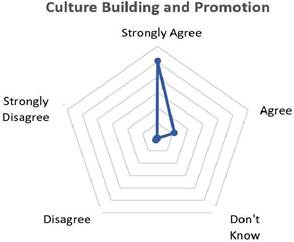
Chart 5: The Distribution of Responses about Culture Building and Promoting entrepreneurial activities
Moreover, according to Chart 6, the major part of respondents completely agreed upon “Improving entrepreneurial capabilities” as a main function of S&T parks.
Similarly, according to Chart 7 and Chart 8, most respondents completely agreed upon “Stabilizing knowledge-based businesses” and “Supporting the development of knowledge-based businesses” as two main functions of S&T parks.
The third and final part of the questionnaire included questions about the solutions for realizing each function. In these questions, the respondents were allowed to choose more than one option. Thus, as an example, “Venture capital financing” was equally pointed out as a viable solution in all four functions. Regarding the above- mentioned issues, for each solution, the function(s) with the highest level of consensus were the best places to use the solution.
Based on the results derived from the questionnaire, the conceptual business model for SBU S&T park was developed.
5. DISCUSSION AND CONCLUSION
S&T parks are taking on an increasingly crucial role in the development of countries. Accordingly, integrating the factor of S&T parks into the economy nowadays is of enormous significance. This research attempted to draw on previous studies on S&T parks and their various functions in order to obtain a general view of the functions expected from an S&T park. In previous works, no attention was paid to the role of university S&T parks in developing an entrepreneurial university. Therefore, this study, took into account all dimensions of an entrepreneurial university and the role of S&T parks in forming such universities. This led to a list of expected functions. Afterwards, using the opinions of those experts working either in the park or in the entrepreneurial university, four major functions of the S&T parks were extracted as shown in Figure 10. The figure also shows that R&D centers and incubators within the park, sponsored by funds and venture capital firms, perform activities such as human resource training, creating academic teams, establishing companies and products, etc. As shown in Chart 9, the solution to each function was determined. The solutions and their corresponding functions are listed in Table 6.













